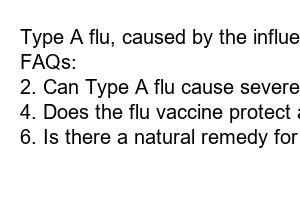A형독감
Title: Type A Flu: Symptoms, Preventive Measures, and Treatment Options
Introduction:
Type A flu is a highly contagious respiratory illness caused by the influenza A virus. It commonly affects humans and animals alike, with the potential to cause seasonal epidemics or even global pandemics. In this blog post, we will delve into the details of Type A flu, its symptoms, preventive measures, and available treatment options.
Understanding Type A Flu:
Type A flu is known for its rapid onset and severity, often leading to significant illness and potential complications. Characterized by symptoms such as fever, cough, sore throat, fatigue, and muscle aches, this strain of flu can spread easily through respiratory droplets. It gets transmitted from person to person, particularly when an infected individual coughs, sneezes, or talks.
Symptoms to Watch Out For:
1. Fever: With temperatures often exceeding 100 degrees Fahrenheit, a high fever is one of the primary symptoms of Type A flu.
2. Cough: A persistent, dry cough is common, often accompanied by a sore throat.
3. Fatigue: Unusual tiredness and weakness are observed, resulting in decreased productivity and increased need for rest.
4. Muscle Aches: Severe muscle aches, joint pain, and headaches may affect the infected individual.
5. Respiratory Issues: Shortness of breath or difficulty breathing can occur, particularly in individuals with weak immune systems or underlying health conditions.
Preventive Measures to Take:
1. Vaccination: Annual flu shots are highly recommended, especially for high-risk individuals, including the elderly, pregnant women, and individuals with chronic health conditions.
2. Hand Hygiene: Regularly washing hands with soap and water for at least 20 seconds can significantly reduce the risk of infection.
3. Respiratory Etiquette: Covering the mouth and nose with a tissue or the inside of your elbow when coughing or sneezing can prevent the spread of the virus.
4. Avoid Close Contact: Limit close contact with those exhibiting flu symptoms, and if possible, stay away from crowded places during flu season.
5. Boost Your Immunity: Eating a nutritious diet, getting enough sleep, engaging in regular physical exercise, and managing stress can enhance your immune system’s resilience against flu viruses.
Treatment Options Available:
1. Antiviral Medications: Prescription antiviral drugs, such as oseltamivir (Tamiflu), are recommended within 48 hours of symptom onset to reduce the severity and duration of Type A flu.
2. Symptom Relief: Over-the-counter medications can alleviate symptoms like fever, congestion, and sore throat, providing temporary relief.
3. Rest and Hydration: Adequate rest and fluid intake are essential to support the body in fighting off the infection.
Summary:
Type A flu, caused by the influenza A virus, can lead to severe illness and complications. Recognizing the symptoms and taking immediate preventive measures, such as vaccination, hand hygiene, and avoiding close contact, can help minimize its impact. Antiviral medications and symptom relief methods are available for treatment. Prioritize your health, adopt preventive measures, and stay informed during flu season to reduce the risk and spread of Type A flu.
FAQs:
1. What is the difference between Type A and Type B flu?
2. Can Type A flu cause severe illness in healthy individuals?
3. How long does it take to recover from Type A flu?
4. Does the flu vaccine protect against Type A flu?
5. Is the flu contagious before symptoms appear?
6. Is there a natural remedy for Type A flu symptoms?

